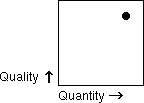
GENERAL PHILOSOPHY
The LRO is a process-oriented method of learning and assessment that examines development and quality of student work and encourages students to reflect on and learn from their development, processes, and texts. One of the key principles of the LRO is development/improvement. However, as McIntire-Strasburg reminds us (paraphrasing Nancy Sommers), when we assign pre-writing strategies and multiple drafts, we still do so in order to help students achieve an ideal finished text. McIntire-Strasburg suggests that in doing so, we are encouraging students to "view revision as an either/or process with successively 'improved' choices." In turn, we "'exclude life and real revision by pushing [us] to safe positions […] that exclude each other and don't allow for any ambiguity or uncertainty'" (Sommers 317; qtd. in McIntire-Strasburg). Although focusing on improvement and progress, the LRO avoids this type exclusion by allowing for different types of writing (observations, reflection) and by focusing on improvement in terms of personal growth, knowledge, and development and not strictly in terms of grammar, word choice, and revision. Although many teachers that work with the LRO encourage students to revise, improve each draft, and include these drafts/improvements in the LRO, the LRO is about much more than revised, improved and idealized texts. The LRO is about continued growth, and in this sense, about improvement and development.
The LRO takes a new and relatively radical approach to evaluating student work. To encourage writing to learn and writing as on-going creation (and not simply an achieved ideal), teachers assess student development, processes, and products by using small multiples (see below) to account for the substance and quality of student work.
Students do not know their grades on individual assignments and do not know their course grade until midterm and the end of the semester. Every assignment, of each student, has a graph that tracks quality and quantity of work. Here is an enlarged example taken from the Dr. Syverson's explanation of small multiples:

Note: You can change the axes to suit you and your students.
Although some teachers choose to still assign a traditional letter or number grade to each assignment, which they do not let the students know, the small multiples system works best, for it allows teachers to visually track student progress across time and space. Likewise, not giving students "grades" (in the traditional sense), encourages students to work for learning and development's sake.
In addition, this system of evaluation accounts for learning that is not reflected in traditional papers (such as learning to work with computers, learning about the research process, confidence and independence, etc.) Many times, students learn a lot, but quality wise, their writing is still not very strong; if a student begins the semester as a very weak writer and ends the semester as a stronger writer, but still fairly weak, the LRO accounts for this development/improvement by asking students to reflect on and write about their development.
Although the small multiples chart above does not account for improvement (in terms of the axes) on an individual assignment, it does account for effort and commitment to the work (quantity). In addition, the basic skills/knowledge (grammar skills, organization, support, etc.) that can be demonstrated through traditional papers are still accounted for using this model of assessment. After all, if a student has learned and developed his/her writing skills, then the student's papers will reflect such development. However, concerning other forms of development (as seen in the observations and part B), the LRO suggests the following grading scale (see note 1):
A Represents outstanding participation in all course activities; all assigned work completed, with very high quality in all work produced for the course. Evidence of significant development across the five dimensions of learning. The Learning Record at this level demonstrates activity that goes significantly beyond the required course work in one or more course strands. B Represents excellent participation in all course activities; all assigned work completed, with consistently high quality in course work. Evidence of marked development across the five dimensions of learning. C Represents good participation in all course activities; all assigned work completed, with generally good quality overall in course work. Evidence of some development across the five dimensions of learning. D Represents uneven participation in course activities; some gaps in assigned work completed, with inconsistent quality in course work. Evidence of development across the five dimensions of learning is partial or unclear. F Represents minimal participation in course activities; serious gaps in assigned work completed, or very low quality in course work. Evidence of development is not available. Notice that each grade takes into account development as well as quality of work. Since colleges still require a final course letter grade, we have to assign them. However, we can put the focus back on learning, creating (as a process and not as an ideal), and working by evaluating student work in a way that accounts for all aspects of learning and encourages such learning.
In essence, the LRO serves as a forum for creation and learning and as evidence of all types of development.
Note 1: The grading scale comes as the default grading scale in the LRO, but you have the option to add, change, or delete components when setting up your new course.
Demonstration, Observation, and Knowledge